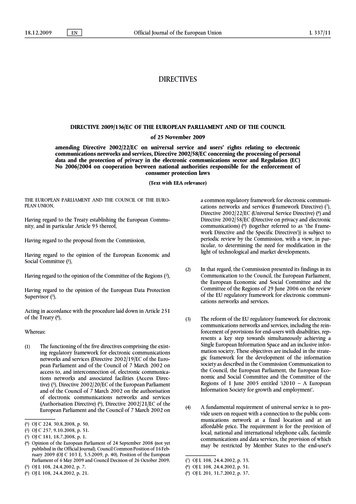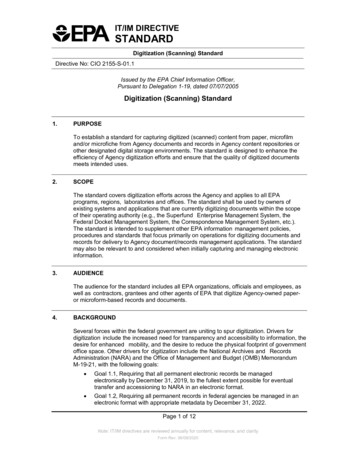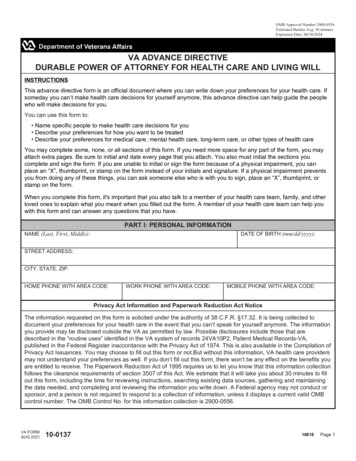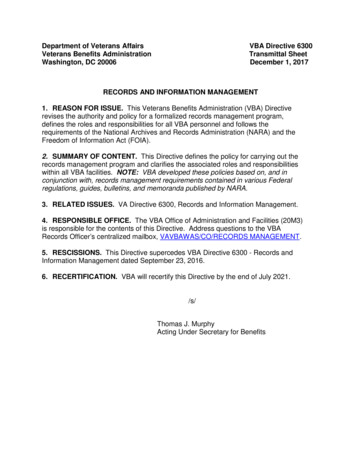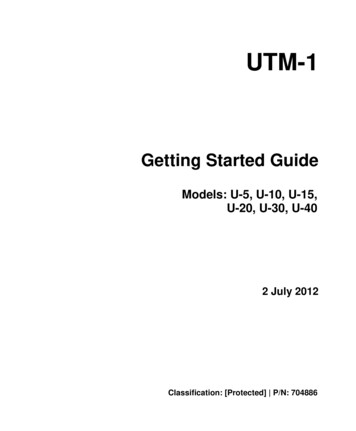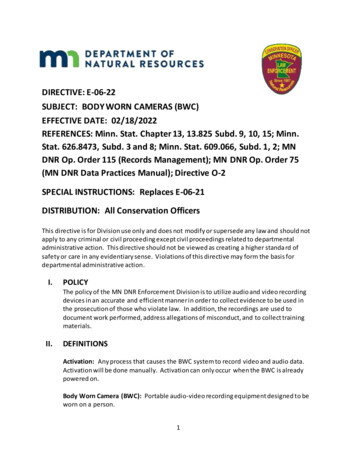
Transcription
DIRECTIVE: E-06-22SUBJECT: BODY WORN CAMERAS (BWC)EFFECTIVE DATE: 02/18/2022REFERENCES: Minn. Stat. Chapter 13, 13.825 Subd. 9, 10, 15; Minn.Stat. 626.8473, Subd. 3 and 8; Minn. Stat. 609.066, Subd. 1, 2; MNDNR Op. Order 115 (Records Management); MN DNR Op. Order 75(MN DNR Data Practices Manual); Directive O-2SPECIAL INSTRUCTIONS: Replaces E-06-21DISTRIBUTION: All Conservation OfficersThis directive is for Division use only and does not modify or supersede any law and should notapply to any criminal or civil proceeding except civil proceedings related to departmentaladministrative action. This directive should not be viewed as creating a higher standard ofsafety or care in any evidentiary sense. Violations of this directive may form the basis fordepartmental administrative action.I.POLICYThe policy of the MN DNR Enforcement Division is to utilize audio and video recordingdevices in an accurate and efficient manner in order to collect evidence to be used inthe prosecution of those who violate law. In addition, the recordings are used todocument work performed, address allegations of misconduct, and to collect trainingmaterials.II.DEFINITIONSActivation: Any process that causes the BWC system to record video and audio data.Activation will be done manually. Activation can only occur when the BWC is alreadypowered on.Body Worn Camera (BWC): Portable audio-video recording equipment designed to beworn on a person.1
DIVISION OF ENFORCEMENTDIRECTIVE: E-06-21SUBJECT: Body Worn CamerasBWC Uploading: The act of transferring recorded data from the BWC to the storageserver.Critical Incident: For purposes of this directive, a critical incident is an incidentoccurring in the line of duty involving the use of deadly force by or against conservationofficers, death or great bodily harm incurred by conservation officers, or an action by aconservation officer that causes or is intended to cause death or great bodily harm.Deadly Force: Force which the officer uses with the purpose of causing, or which theofficer should reasonably know creates a substantial risk of causing, death or greatbodily harm. The intentional discharge of a firearm, other than a firearm loaded withless lethal munitions and used by an officer within the scope of official duties, in thedirection of another person, or at a vehicle in which another person is believed to b e,constitutes deadly force.Deactivation: Any process that causes the BWC system to stop recording. Deactivationcan be done manually or can occur unintentionally.Evidentiary Value: The information may be useful in a criminal prosecution, related civilor administrative proceeding, further investigation of an actual or suspected criminalact, or in considering an allegation against a law enforcement agency or officer.Great Bodily Harm: Bodily injury which creates a high probability of death, or whichcauses serious permanent disfigurement, or which causes a permanent or protractedloss of impairment of the function of any bodily member or organ or other seriousbodily harm.Regulatory Checks: The act of checking a person for a game or fish license required bylaw.Stops: Preventing a person, vehicle, or watercraft from freely leaving due to a violationor investigation of a law, rule, commissioner’s order, or water-surface use ordinance.Unintentionally Recorded Footage: A video recording that results from an officer’sinadvertence in operating the officer’s BWC, provided that no portion of the resultingrecording has evidentiary value. Examples of unintentionally recorded footage include,but are not limited to, recordings made in restrooms, and recordings made whileofficers were engaged in conversations of a non-business, personal nature with theexpectation that the conversation was not being recorded.2
DIVISION OF ENFORCEMENTDIRECTIVE: E-06-21SUBJECT: Body Worn CamerasIII.USE REQUIREMENTSA. General Use1. Officers shall have their BWC powered on during their work day when not working intheir office. Officers shall activate their Enforcement Division-issued Body WornCameras (BWCs) when anticipating that they will be involved in, become involved in, orwitness other officers of this Division involved in:a. All stops, pursuits, emergency vehicle operations, assistance to other lawenforcement agencies, transports of individuals in custody, and all otherinvestigative and enforcement-related interactions with the public that involve aviolation of law.b. Regulatory checks when there is a known or suspected violation prior to the contact.c. When actively involved with crowd control/civil unrest/special response team callout.d. When directed by a supervisor.2. Officers may use discretion in activating their BWC during interactions with the publicthat are confrontational but not a suspected or actual violation of law.3. Exceptions:a. When impossible due to an unusually sudden and/or dangerous event in which areasonable officer under similar circumstances would be unable to activate theBWC. In this event, the officer shall immediately notify a supervisor. The officer shalldocument the circumstances and reason for not activating their BWC in their ICR.b. When there was a recording equipment failure properly reported pursuant toSection III for which there is no immediate remedy.c. When the officer is acting as a crew or observer aboard any aircraft.d. When assigned to the Special Investigations Unit (SIU) and working in a covertcapacity where the wearing of a BWC would jeopardize the safety of the covertofficer.e. When actively involved as a plain clothes officer or working with an undercoverinvestigator and having obtained prior permission from their supervisor.f. When attending an event requiring the wearing of a Class A uniform and the Class Ajacket is being worn.g. While attending training unless otherwise directed by a supervisor.4. Once activated, the BWC shall continue recording until the conclusion of the incident orencounter, or until it becomes apparent that additional recording is unlikely to captureinformation having evidentiary value.5. If the recording is discontinued while an investigation, response, or incident is ongoing,officers shall state the reasons for ceasing the recording on camera before deactivating3
DIVISION OF ENFORCEMENTDIRECTIVE: E-06-21SUBJECT: Body Worn Camerasthe BWC. If circumstances change, officers shall reactivate their cameras as required bythis policy to capture information having evidentiary value.6. Officers may mute the audio on their BWC while discussing sensitive tactical informationor during coaching conversations between a field training officer and their conservationofficer candidate. Prior to muting the audio the officer must state the reason on camera.7. Officers shall not intentionally turn off, block, or otherwise disable the BWC’s audio orvisual recording functionality to defeat the purposes of this directive.8. Live streaming of another officer’s BWC shall be used only in the following cases and theofficer must be notified expeditiously of the activation:a. When there’s a clearly established law enforcement purpose, or to determine theBWC user’s location and status if there is a legitimate concern for their safety, or thesafety of another individual. The reasons for remote activation shall be documentedin an incident report. Additional justification is necessary if a BWC is remotelyactivated without an audible warning being provided to the BWC user.b. For demonstration, training, or testing purposes, but only with the BWC user’spermission.c. Remote activation shall not be used as a supervision tool or as a means forsurreptitious monitoring.B. Wearing of BWCsBWCs shall be worn consistent with training and in a conspicuous manner thatmaximizes the view of the camera.1. The BWC must be worn on the outermost garment with a Division-approved mount,whether shirt or jacket, with an unobstructed field of view.2. The BWC must be worn at chest level.C. Evidentiary ValueWhenever a BWC recording documents an arrest, investigation or other significantincident, the recording constitutes evidence and the legal rules of evidence apply. Assuch, care must be taken toward documenting and maintaining a chain of custody andensuring the integrity of those recordings.IV.RESPONSIBILITIESA. Officers1. The following responsibilities apply to BWC:a. Record all law enforcement stops, pursuits, emergency vehicle operations, andall other investigative and law enforcement-related interactions with the public.b. Record statements from persons believed to be victims of and witnesses tocrimes, and persons suspected of committing crimes, considering the needs of4
DIVISION OF ENFORCEMENTDIRECTIVE: E-06-21SUBJECT: Body Worn Camerasthe investigation and the circumstances pertaining to the victim, witness, orsuspect. This does not apply to a witness who wishes to remain anonymous.c. Officers shall use their BWCs to record the transportation of suspects, witnesses,victims, complainants, or public assists in their squad.d. Inform those who ask that recording equipment is in use.e. Inspect the BWC equipment at the start of each work day to ensure the cameradisplays “ready” and no error lights are displayed.i. Report any defect in condition or performance in writing to a supervisorimmediately. Obtain a spare functioning BWC as soon as feasible.ii. Officers shall periodically check recordings to ensure that thetime/date/name/badge are accurate and that the camera and microphoneare working properly. Notify a supervisor immediately if issues arediscovered.f. Ensure that BWC video is categorized correctly with the system. Categorizationis critical for proper data retention. If an officer needs to assign a three year orseven year retention to a video, the ICR number assigned to the event must beentered.g. Under no circumstances shall an officer personally sell, transfer, share access, ordistribute copies of BWC recordings except as provided under III, A, 3.h. Subpoenas, data practices requests, or other requests for recordings outside thescope of normal investigative processes shall be referred to the Division’s datapractices designee.2. BWCa. Axon BWC:i. Charging: The BWC charge shall be properly maintained to ensurefunctionality. The BWC must be charged with either: An Axon-provided USB-C cable. Other branded charging cables shall notbe used. The Axon USB-C cable facilitates the ability to charge the BWCwhile it is being worn. An Axon-provided docking station.ii. Upload: When a BWC event has concluded and the video recording isstopped, it shall be properly categorized (see below) and immediatelyselected for upload through the Axon View XL app or as soon as practical.90 Day – Unintentional recorded footage (see definition)One Year – this is the default for all recordings and does not require any furtheraction from the officer. This includes, but not limited to: Game and Fish violations5
DIVISION OF ENFORCEMENTDIRECTIVE: E-06-21SUBJECT: Body Worn Cameras Recreational vehicle violationsTrespassThree Year – this includes, but not limited to: DUIs BUIs HUIs Wetland Conservation Act Violations Formal Complaints Cases, that a reasonable officer is inclined to believe, may take longer than 1year to resolveSeven Year – this includes, but not limited to: Critical Incidents Civil Unrest Litigation Holds Use of Force/RTR Pursuitsiii.Firmware Updates: The BWC must be connected to the laptop computerwith the supplied USB-C cable and synced with Axon View XL (or docked in adocking station) at least every 30 days (monthly) to ensure firmware is up todate.3. Reviewing of BWC RecordingsThe video storage platform has integrated auditing and viewing. All access andattempts to access video are tracked at the individual level. This directive serves aswritten authorization, as required by Minn. Stat. § 13.825, to access video under thefollowing circumstances:a. All access shall be for law enforcement purposes only.b. Supervisors, legal counsel, and the data practices designee may access BWCdata in order to complete their duties. Bi-annual internal supervisory auditsand reviews are mandatory to ensure compliance with this directive and law(Minn. Stat. 626.8473).c. Special Investigation Unit (SIU) investigators may access BWC data for caseinvestigation purposes with prior approval from SIU manager.d. With approval from the Director, for training or incident review purposes.e. When an officer receives a request for copies or review from other lawenforcement agencies, it must be in writing and directed to the Division datapractices designee for approval.6
DIVISION OF ENFORCEMENTDIRECTIVE: E-06-21SUBJECT: Body Worn Camerasf. Officers are only allowed to access their own BWC data or view other officers'footage for case investigation, report writing, court preparation, or other lawenforcement related purposes.g. In a critical incident, officers will follow direction outlined in directive O-2.h. Data shall be made available to prosecutors, courts, and other criminal justiceentities as provided by law.i. Authorized support staff may download copies of case files for prosecutors,however viewing the data requires additional approval from the data practicescoordinator.j. In compliance with data practices laws, including pursuant to Minn. Stat. §13.82, Subd. 15 (public benefit data).B. Data Practices Designee1. Coordinate and respond to data requests regarding MN DNR Enforcement DivisionBWC recordings.2. Review all recordings prior to public release to ensure compliance with Minnesotadata practices laws.3. Prior to releasing video, notify involved officers of data request and upcomingrelease date.4. Arrange for an independent biennial audit of BWC data and ensure results areshared as required by Minn. Stat. § 13.825, subd. 9.5. Arrange and conduct internal audits of BWC data twice annually to ensure officersare in compliance with data laws and retention policies.6. Maintain the following public BWC data as required by Minn. Stat. § 13.825, subd.5:a. The total number of devices owned by the Division;b. A daily record of the total number of devices actually deployed and used;c. The policies and procedures for use of portable recording systems; andd. The total amount of recorded audio and video data collected by the portablerecording system and maintained by the Division, the Division’s retentionschedule, and the Division’s procedures for destruction of the data.7. Ensure that the BCA is notified within ten (10) days of acquiring new BWCtechnology, as required by Minn. Stat. § 13.825, subd. 108. In instances where an officer has used deadly force, as defined by Minn. Stat. §609.066, subd. 1, against an individual and the individual has died as a result, theDivision will allow the representative of a decedent an opportunity to view BWCvideo within five (5) days of the incident or a request. The disclosure must be inaccordance with the Minnesota Government Data Practices Act, MinnesotaStatutes, chapter 13, which may require redaction.7
DIVISION OF ENFORCEMENTDIRECTIVE: E-06-21SUBJECT: Body Worn CamerasV.USE AND ACCESS REGARDING BWC VIDEOA. BWC recordings generated in connection with an officer’s duties are the exclusiveproperty of the MN DNR Enforcement Division and shall not be available for externaluse, except as provided in this directive and under state law.B. BWC recordings are subject to the Minnesota Data Practices Act (Minn. Stat. Chapter13). BWCs are also specifically subject to Minn. Stat. § 13.825.C. Officers are prohibited from using Division-issued BWCs for personal use or whileworking other jobs outside the MN DNR Enforcement Division.D. Officers are prohibited from using personal recording devices to record lawenforcement contacts while on duty.E. Officers are prohibited from retaining, duplicating, or distributing any recordings madeexcept those needed by authorized persons for business reasons as specified in othersections of this directive.VI.RETENTION OF BWC RECORDINGSA. All BWC recordings, including unintentionally recorded footage, shall be kept inaccordance with Chapter 13 and the MN DNR’s records retention schedule.B. Upon written request, the Enforcement Division will retain the relevant BWC videobeyond the normal retention period and up to 180 additional days. At that time, theEnforcement Division will notify the subject that the data will be destroyed unless a newrequest is made.By Authority of:Rodmen SmithDigitally signed by RodmenSmithDate: 2022.02.18 08:26:54-06'00'COL Rodmen SmithDivision DirectorDivision of Enforcement8
DIVISION OF ENFORCEMENT DIRECTIVE: E-06-21 SUBJECT: Body Worn Cameras 2 BWC Uploading: The act of transferring recorded data from the BWC to the storage server. Critical Incident: For purposes of this directive, a critical incident is an incident occurring in the line of duty involving the use of deadly force by or against conservation
